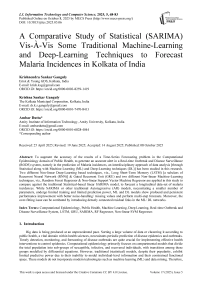A Comparative Study of Statistical (SARIMA) Vis-À-Vis Some Traditional Machine-Learning and Deep-Learning Techniques to Forecast Malaria Incidences in Kolkata of India
Автор: Krishnendra Sankar Ganguly, Krishna Sankar Ganguly, Ambar Dutta
Журнал: International Journal of Information Technology and Computer Science @ijitcs
Статья в выпуске: 5 Vol. 17, 2025 года.
Бесплатный доступ
To augment the accuracy of the results of a Time-Series Forecasting problem in the Computational Epidemiology domain of Public Health, to generate an accurate alert in a Real-time Outbreak and Disease Surveillance (RODS) system, namely in the prediction of Malaria incidences, an interdisciplinary approach of data analysis [through Statistical along with Machine-Learning (ML) and Deep-Learning techniques (DL)] has been studied in this research. Two different Non-linear Deep-Learning based techniques, viz., Long Short-Term Memory (LSTM) [a subclass of Recurrent Neural Network (RNN)] & Gated Recurrent Unit (GRU) and two different Non-linear Machine-Learning techniques, viz., Random Forest Regressor & Non-linear Support Vector Machine Regressor are applied in this study to compare against the traditional Statistical-based linear SARIMA model, to forecast a longitudinal data-set of malaria incidences. While SARIMA or other traditional Autoregressive (AR) models, necessitating a smaller number of parameters, undergo limited training and limited prediction power, ML and DL models show profound and persistent performance improvement with better noise-handling/ missing values and perform multi-step forecasts. Moreover, the over-fitting issue can be combated by introducing densely connected residual links in the ML/ DL networks.
Computational Epidemiology, Public Health, Machine Learning, Deep Learning, Real-time Outbreak and Disease Surveillance System, LSTM, GRU, SARIMA, RF Regressor, Non-linear SVM Regressor
Короткий адрес: https://sciup.org/15020018
IDR: 15020018 | DOI: 10.5815/ijitcs.2025.05.06


